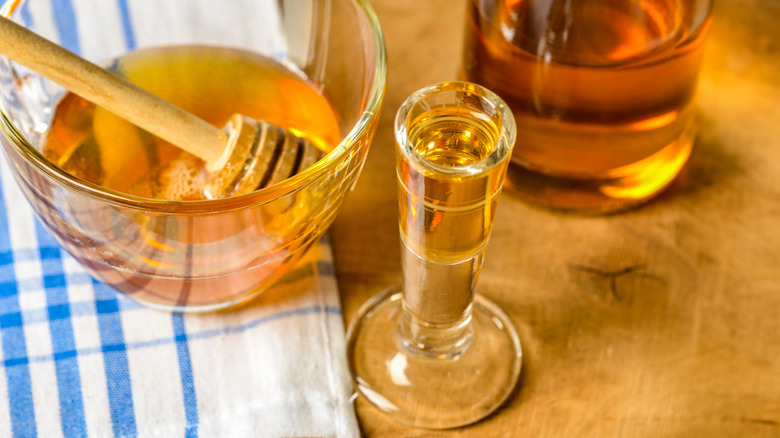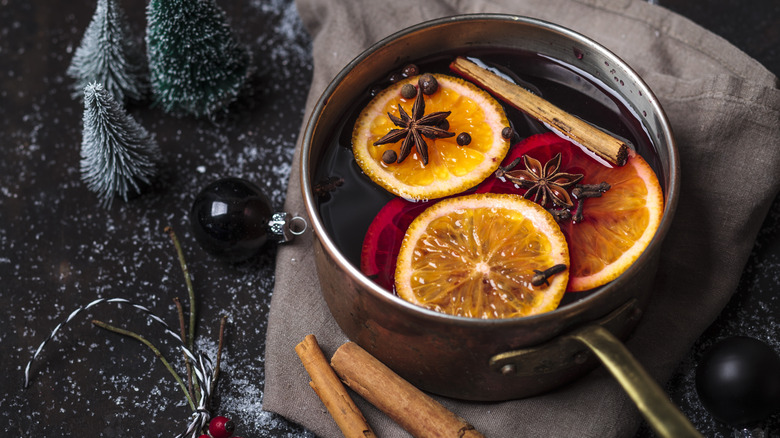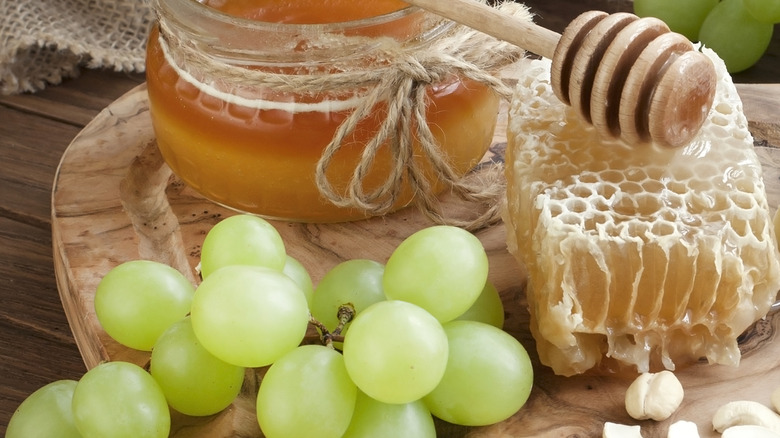Mead Vs Wine: Are They The Same Thing?
Though there's some debate about which beverage was invented first, scholars agree that mankind has been enjoying both wine and mead for thousands of years. It seems that once humans discovered how to use yeast to ferment honey and fruit, we lost no time in experimenting with and standardizing the process of making both drinks. Today, skilled wine and mead-makers worldwide continue to build on our ancestors' work to produce some truly nuanced and flavorful varietals.
However, despite their possible shared origins, wine and mead are quite distinct from one another. Mead may have the colloquial name "honey wine," but it's not truly a wine. It's similarly incorrect to say that wines fermented with honey are mead. In fact, it's incredibly rare for wineries to produce mead since each product requires specific ingredients. Similarly, meaderies usually focus solely on perfecting their honeyed offerings in order to offer their clientele the best possible product.
What is mead?
Mead-making has changed very little since ancient times. Both ancient and modern mead are made with the same basic ingredients — honey, water, and yeast. After blending these ingredients together, mead-brewers allow the mixture to ferment and age until it's reached the desired flavor and alcohol content. The resulting beverage is usually pale or golden yellow and lightly sweet with earthy notes from the honey. Many meads also have floral notes from wildflower honey, but darker honeys — such as buckwheat honey — may produce richer, nutty undertones instead.
Though the mere mention of mead likely conjures up images of armored Vikings singing and toasting over roasted meats and mythical tales, mead most likely made its debut in ancient China around 7,000 B.C., according to archeological evidence. Similar evidence from slightly more recent millennia was also found in India, Greece, Rome, and Egypt, indicating mead was enjoyed throughout the ancient world for thousands of years.
So, while the image of Norsemen enjoying mead from ale horns isn't incorrect, it's far from the first time people gathered over this golden beverage. Often the subject of folktales, mead was also frequently used in rituals and as part of offerings to pagan gods. This reverence may be because honey never expires, which would have seemed miraculous in the ancient world.
What is wine?
Simplistically speaking, wine is a blend of crushed grapes (or other fruit), yeast, water and sometimes sugar. This mix is then allowed to ferment and age to develop alcohol content and wine's notoriously complex flavor. Red wines come from grapes fermented with the skins in the mix — to make white wines, the skins are removed during the crushing process. Other fruits, such as blueberries, apples, and even pineapples, may be used in place of grapes to make innovative fruit wines.
Though there is some evidence that wine made its debut in China around 9,000 years ago (possibly alongside mead), definitive evidence of wine production doesn't pop up until the 6th millennium B.C. in what is present-day Armenia, Türkiye, and Georgia. Artifacts found in these regions include strong evidence of wine production and storage — such as vessels with wine residue inside — and indications of early grape domestication. This makes sense considering these regions are still famous for their wine grapes today.
In modern times, winemakers across the globe use these and other carefully cultivated wine grapes to make wines ranging in color from burgundy and rosé pink to golden and pale lemon yellows. These wines also vary in flavor from rich and dry to light, bright, and sweet. German ice wines are especially sweet, being made from grapes allowed to freeze on the vine to enhance their natural sugars.
Mead & wine's shared origins (plus other similarities)
Mead and wine are both extremely ancient, with origins as far back as the 7th millennium B.C. It's hard to tell which came first, as the original wine mixture discovered included grapes blended with honey and rice. Grapes may have been the star of the beverage, with rice added as the yeast component and honey to feed the yeast and aid fermentation. However, similar blends sans grapes have also been discovered, so it's hard to tell if honey or grapes would have been the main flavor.
The process of making mead vs. wine is also very similar. Both start with a blend of the main ingredient (honey vs. grapes or other fruit) and yeast. That blend is then fermented and aged to the desired ABV and flavor profile. Mead and wine both range in alcohol content between approximately 3% and 23% ABV, depending on how much sugar is available for the yeast to process and how long the drink is aged.
Mead and wine are also both incredibly versatile and come in a wide range of varieties. For instance, a strawberry-flavored mead may complement your brunch Belgian waffle just as well as a light and bubbly rosé wine. Spiced mead and fortified wine may also be warmed to just below boiling and enjoyed with an orange slice on a cold winter night.
Mead and wine differences
Despite mead sometimes being called "honey wine," it's in a classification all its own. The central ingredient in wine is fermented fruit juice or crushed fruit. While honey may be added to wine to aid fermentation, the resulting beverage must be fruit-forward in order to be called wine. Meanwhile, the main ingredient in mead must be honey. Though meaderies may add fruit flavoring to their products, it is to complement the nuances of the honey, not to mask them.
Additionally, mead is nearly always much sweeter than wine, especially red varietals. If you prefer a dry red wine over sweeter fortified blends, mead may not be your proverbial cup of tea. Mead tastes much closer to a white dessert wine, like Moscato or zinfandel, but with the earthy florals of honey rather than the sharp sweetness imparted by grapes or other fruits.
Conversely wine, as mentioned, comes in a wide array of flavor profiles. Reds tend to feature notes of dark fruits like cherries and plums, while whites often taste crisp with a citrusy undertone. In dry wines, these fruity undertones are almost never accompanied by sugary sweetness, and even sweet wines feature a touch of acidity to keep the flavor complex and refreshing.




